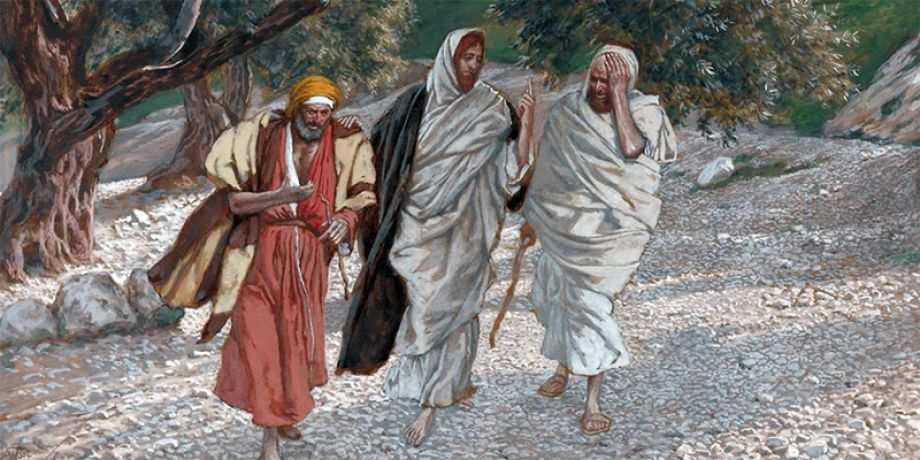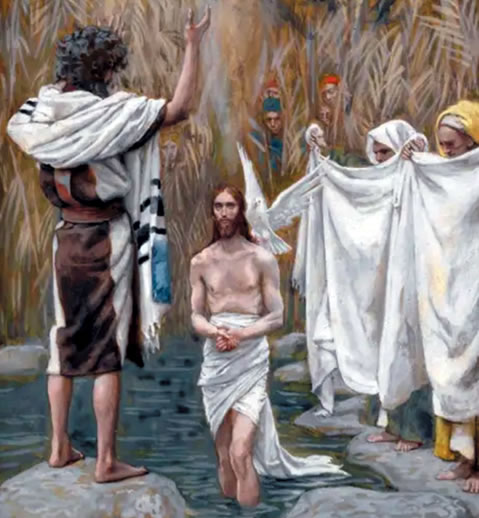
In this article, Columban Fr. Michael Riordan shares about his reflection on two important Gospel events, the baptism of Jesus by John and the disciples encountering the resurrected Christ on the road to Emmaus. The reflection focuses on the illustration art and etching works that serve as support to their sculpture counterpart found in the Hill of Grace in Isidore Farm. The exact pieces from Isidore Farm are not shown.
Isidore Baptism Scene
In our Hill of Grace Shrine on Isidore we have a park with a series of sculptures showing some of the events of the life of Christ. One of the events depicted is the Baptism in Jordan. The relevant scripture highlights the interaction between John the Baptist and Jesus and also how Jesus is affirmed by the Father after His Baptism. For the reasons of monetary constraint, we have just two statues in this scene. I wanted them to see more than this, I wanted to show the context of the Baptism; to look at why Jesus chose to be baptized. In the Catholic Church we learn that Baptism has a number of effects. These include becoming a member of the Church and the removal of original sin from our souls. At the time Jesus was baptized there was no Church and also we believe that Jesus did not have original sin so why did He chose it? Some might claim He was going through the motions so as to provide us with an example of what we should do. I am not so sure of that!
 When I think of why Jesus chose to be baptized I came up with the following (not original) thought. Jesus had left home and was about to begin His public life; He had to chose whether to go it alone or to align Himself with some group. Because of His background and economic status being a lawyer or a Pharisee probably was out of the question. He didn’t belong to a priestly family so priesthood was out for Him, unlike His cousin John the Baptist, who could have been a priest but felt called to be a lay prophet instead. Most of the groups at the time were limited to men and possibly the only group which was open to all, rich or poor, well educated or otherwise, young or old, men or women, was the group which followed John the Baptist. Jesus by being baptized by John as He began His public life showed that He was completely “Catholic,” that is, universal and in no way exclusive. He aligned Himself to the one group to which everyone could belong. He could not choose where to be born but in choosing Baptism He affirmed God’s choice of being one among the masses; and so, I think God affirms Him in His choice. Because of the limitations of what we could show in the sculpture I asked that our baptism scene be the foundation and to add others to the scene. Therefore, the scene that was created shows many others in the scene among them some who have already been baptized and other in the water waiting their turn for baptism. The scene shows that Jesus is indeed Emmanuel, the one among us in every sense of the word.
When I think of why Jesus chose to be baptized I came up with the following (not original) thought. Jesus had left home and was about to begin His public life; He had to chose whether to go it alone or to align Himself with some group. Because of His background and economic status being a lawyer or a Pharisee probably was out of the question. He didn’t belong to a priestly family so priesthood was out for Him, unlike His cousin John the Baptist, who could have been a priest but felt called to be a lay prophet instead. Most of the groups at the time were limited to men and possibly the only group which was open to all, rich or poor, well educated or otherwise, young or old, men or women, was the group which followed John the Baptist. Jesus by being baptized by John as He began His public life showed that He was completely “Catholic,” that is, universal and in no way exclusive. He aligned Himself to the one group to which everyone could belong. He could not choose where to be born but in choosing Baptism He affirmed God’s choice of being one among the masses; and so, I think God affirms Him in His choice. Because of the limitations of what we could show in the sculpture I asked that our baptism scene be the foundation and to add others to the scene. Therefore, the scene that was created shows many others in the scene among them some who have already been baptized and other in the water waiting their turn for baptism. The scene shows that Jesus is indeed Emmanuel, the one among us in every sense of the word.
Isidore’s The Road to Emmaus
This is one of my favorite resurrection scenes. The experts have failed to find any village called Emmaus near Jerusalem or to identify to which village the disciples could have been walking. I see this scene as an effort by Luke to describe in what ways the disciples experienced the resurrected Christ, rather than a record of a specific, individual event.
Something that each of the Gospel writers has be contend with is how do you put into words an experience which is so deep, so great that no words can satisfactorily describe it?
In artistic representations of this scripture passage usually the scene depicted is either the two disciples walking along the road talking with Jesus or a Eucharistic scene of Jesus being recognized in the breaking of bread. Usually the disciples are depicted as men, although there is no mention of the sex of the disciples in the text. In depicting the scene in Isidore, I chose to have a male and a female disciple in spite of strong resistance from those around me saying I wasn’t being faithful to the scripture. In fact, I wasn’t unfaithful to the scripture. The scene I chose from the story was when they arrived at their destination and Jesus went to continue on but the disciples offered hospitality to this stranger, and He stayed with them. Had they not done this they may not have recognized Him later for who He was. Their hospitality was the reason they came to know who He was.
Our faith is not static, and we refer to salvation history and to ourselves as a pilgrim people. In the sculpture we had to freeze one moment of the story but I wanted to show that this scene while important was part of the longer journey so there are four different scenes depicted. The first is of the disciples walking with Jesus; the second is of them offering hospitality; the third is the recognizing of Jesus in the sharing of bread and the fourth but not the last is the return of disciples to Jerusalem to share the good news of the resurrection with the other disciples. Each of the stages involves sharing and so in Korean at the center of the drawing we wrote “Sharing: the way of being with Jesus!”
The drawing has the road in the circle which is to show that these events are not one off but are continuous. The disciples continue to experience Jesus on the way in their sharing.
Columban Fr. Michael Riordan lives and works in South Korea.